PA5-40076
antibody from Invitrogen Antibodies
Targeting: RUNX1T1
AML1T1, CBFA2T1, CDR, ETO, MTG8, ZMYND2
Antibody data
- Antibody Data
- Antigen structure
- References [0]
- Comments [0]
- Validations
- Western blot [1]
- ELISA [2]
- Chromatin Immunoprecipitation [3]
- Other assay [2]
Submit
Validation data
Reference
Comment
Report error
- Product number
- PA5-40076 - Provider product page

- Provider
- Invitrogen Antibodies
- Product name
- RUNX1/RUNX1T1 Polyclonal Antibody
- Antibody type
- Polyclonal
- Antigen
- Synthetic peptide
- Reactivity
- Human
- Host
- Rabbit
- Isotype
- IgG
- Vial size
- 100 μL
- Concentration
- Conc. Not Determined
- Storage
- -20°C or -80°C if preferred
No comments: Submit comment
Supportive validation
- Submitted by
- Invitrogen Antibodies (provider)
- Main image
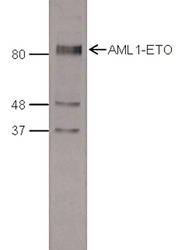
- Experimental details
- Nuclear extracts of SKNO-1 cells (15 µg) were analyzed by Western Blot using a AML1-ETO polyclonal antibody (Product # PA5-40076) at a dilution of 1:1,000 in TBS-Tween containing 5% skimmed milk. The marker (kDa) is shown on the left, the position of the protein of interest is indicated on the right.
Supportive validation
- Submitted by
- Invitrogen Antibodies (provider)
- Main image
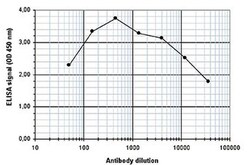
- Experimental details
- To determine the titer of the antibody, an ELISA was performed using a serial dilution of the anti-AML1-ETO antibody (Product # PA5-40076). The plates were coated with the peptides used for immunization of the rabbit. By plotting the absorbance against the antibody dilution, the titer of the antibody was estimated to be 1:32,750.
- Submitted by
- Invitrogen Antibodies (provider)
- Main image
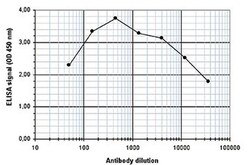
- Experimental details
- To determine the titer of the antibody, an ELISA was performed using a serial dilution of the anti-AML1-ETO antibody (Product # PA5-40076). The plates were coated with the peptides used for immunization of the rabbit. By plotting the absorbance against the antibody dilution, the titer of the antibody was estimated to be 1:32,750.
Supportive validation
- Submitted by
- Invitrogen Antibodies (provider)
- Main image
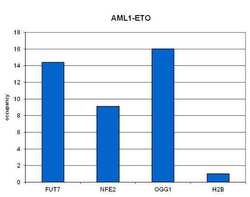
- Experimental details
- ChIP assays were performed on Kasumi-1 cells using a AML1-ETO polyclonal antibody (Product # PA5-40076) and optimized primer pairs for qPCR. Sheared chromatin from 1.25 million cells and 4 µl of antibody were used per ChIP experiment. QPCR was performed on primers specific for the FUT7, NFE2 and OGG1 genes. Figure 1 shows the occupancy, calculated as the ratio + control/background for which the promoter of the H2B gene was used.
- Submitted by
- Invitrogen Antibodies (provider)
- Main image
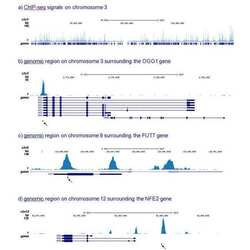
- Experimental details
- ChIP assays were performed on Kasumi-1 cells using a AML1-ETO polyclonal antibody (Product # PA5-40076) and optimized primer pairs for qPCR. Sheared chromatin from 1.25 million cells and 4 µl of antibody were used per ChIP experiment. QPCR was performed on primers specific for the FUT7, NFE2 and OGG1 genes. The IP'd DNA of 6 ChIPs was pooled and analyzed with a Genome Analyzer. The 32 bp tags were aligned to the human reference genome (hg18) using the ELAND algorithm. Figure 2 shows the results of the complete chromosome 3 and three genomic regions surrounding the OGG1, FUT7 and NFE2 genes, respectively. The position of the PCR amplicon is indicated with an arrow.
- Submitted by
- Invitrogen Antibodies (provider)
- Main image
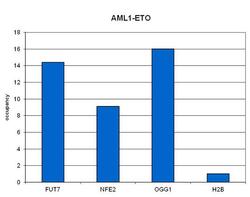
- Experimental details
- ChIP assays were performed on Kasumi-1 cells using a AML1-ETO polyclonal antibody (Product # PA5-40076) and optimized primer pairs for qPCR. Sheared chromatin from 1.25 million cells and 4 µl of antibody were used per ChIP experiment. QPCR was performed on primers specific for the FUT7, NFE2 and OGG1 genes. Figure 1 shows the occupancy, calculated as the ratio + control/background for which the promoter of the H2B gene was used.
Supportive validation
- Submitted by
- Invitrogen Antibodies (provider)
- Main image
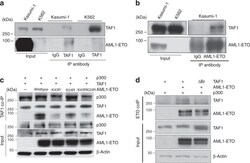
- Experimental details
- Fig. 5 TAF1 associates with acetylated K43 on AE through its bromodomains. a TAF1 physically interacts with AE in Kasumi-1 cells. Co-immunoprecipitation was performed using anti-TAF1 antibody or normal mouse IgG. b Co-immunoprecipitation of TAF1 with AE using anti-ETO antibody or normal goat IgG. c Mutation of lysine-43 to arginine in AE reduces the interaction of AE with TAF1. 293T cells were transfected with p300, TAF1 and AE or AE mutants. Co-immunoprecipitation was performed using an anti-TAF1 antibody. d The deletion of the TAF1 bromodomain regions impairs its binding to AE. 293T cells were transfected with p300, AE, and TAF1 wild type or bromodomain deletion (DeltaBr) plasmids. Co-immunoprecipitation was performed using an anti-ETO antibody
- Submitted by
- Invitrogen Antibodies (provider)
- Main image
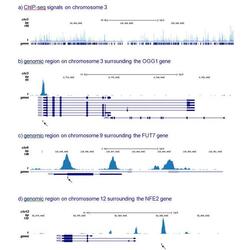
- Experimental details
- ChIP assays were performed on Kasumi-1 cells using a AML1-ETO polyclonal antibody (Product # PA5-40076) and optimized primer pairs for qPCR. Sheared chromatin from 1.25 million cells and 4 µl of antibody were used per ChIP experiment. QPCR was performed on primers specific for the FUT7, NFE2 and OGG1 genes. The IP'd DNA of 6 ChIPs was pooled and analyzed with a Genome Analyzer. The 32 bp tags were aligned to the human reference genome (hg18) using the ELAND algorithm. Figure 2 shows the results of the complete chromosome 3 and three genomic regions surrounding the OGG1, FUT7 and NFE2 genes, respectively. The position of the PCR amplicon is indicated with an arrow.
 Explore
Explore Validate
Validate Learn
Learn Western blot
Western blot